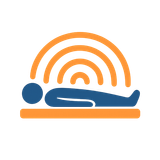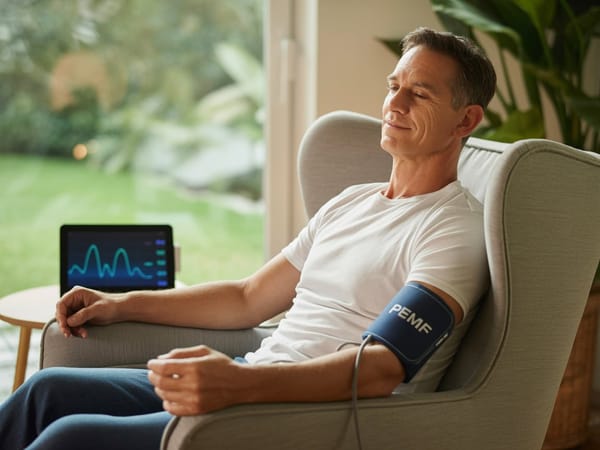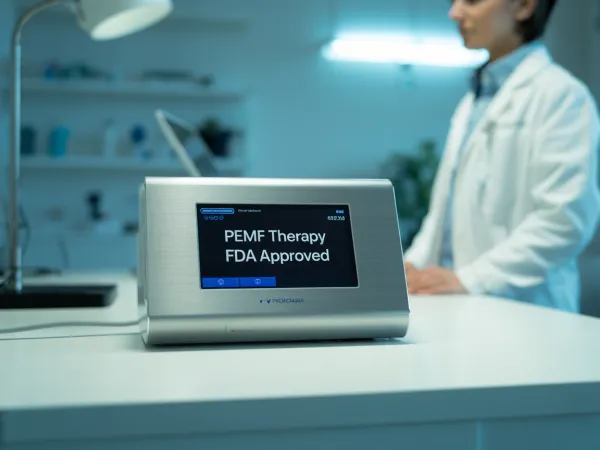Can You Feel PEMF Therapy Working? What to Expect During a PEMF Session
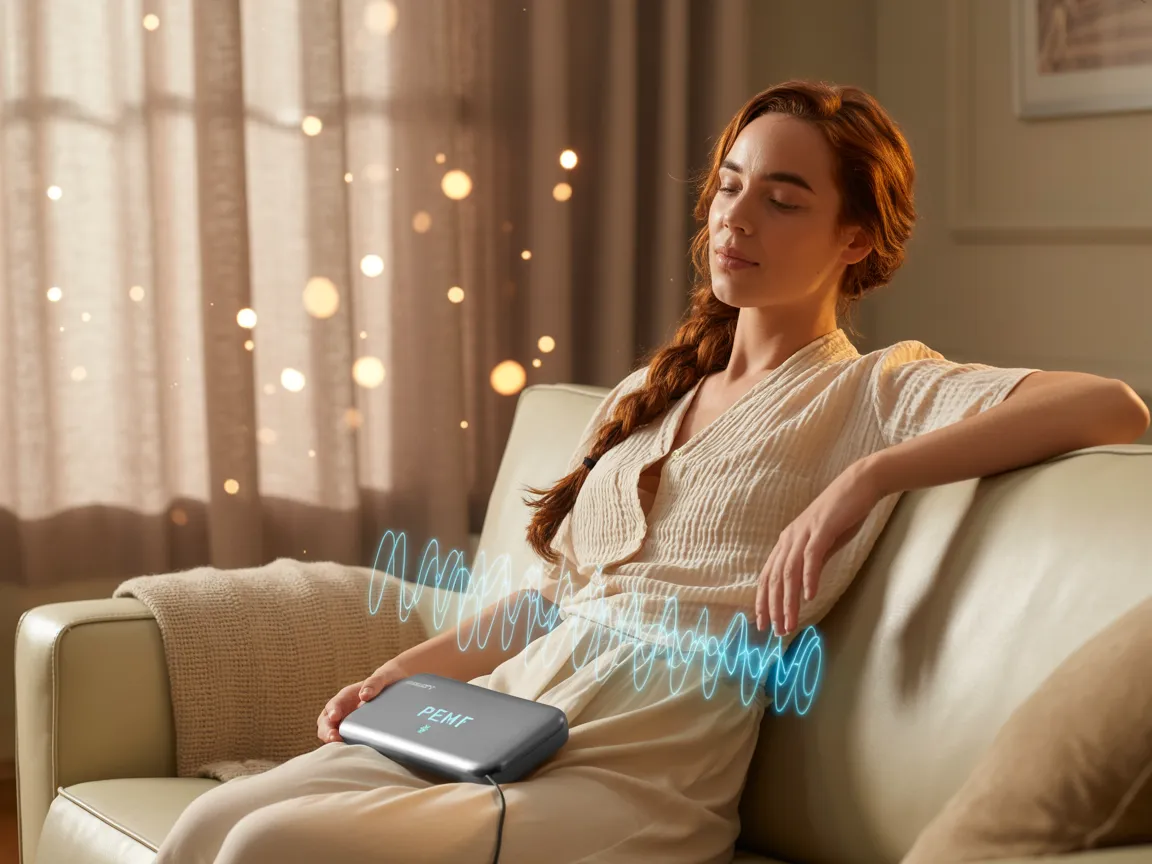
Yes, you can feel PEMF therapy, but the sensations are typically subtle and gentle. Most users report feeling a mild tingling, pulsing, or warmth in the treatment area. The experience is generally described as relaxing and comfortable, with a significant portion of users reporting no distinct sensation at all, yet still experiencing therapeutic benefits.
Executive Summary
- Diverse Sensations: User experiences with PEMF therapy range from gentle tingling and warmth to no sensation at all. According to a clinical guide by the Hope Brain Center, these sensations are a "gentle wake-up call" to the body's cells.
- High Success Rate: Despite the subtlety of the sensations, PEMF therapy has a high success rate for its approved applications. For instance, FDA-approved devices for non-union fractures show an 80% success rate for users who are compliant with the treatment protocol.
- Growing Market: The PEMF therapy device market is projected to grow from USD 557.7 million in 2024 to USD 953.2 million by 2033, with a compound annual growth rate (CAGR) of 6.2%, indicating increasing adoption and trust in the technology.
- Minimal Side Effects: PEMF therapy is known for its safety. Approximately 95% of users experience no side effects. The 5% who do report only mild and temporary symptoms like fatigue or headaches, which are often attributed to the body's detoxification process.
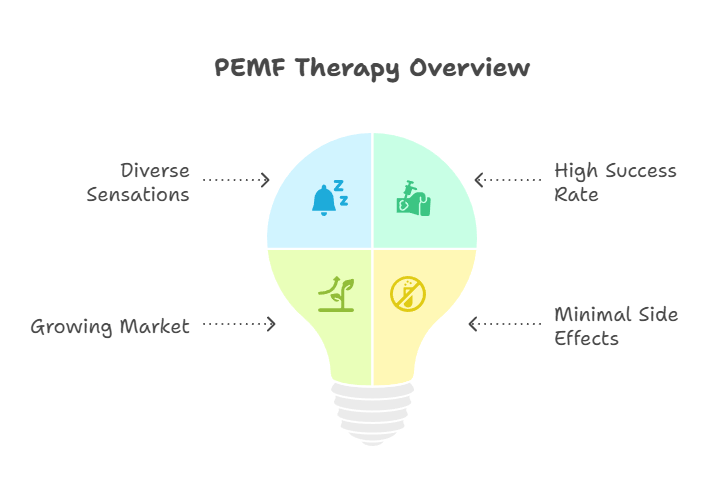
How Does PEMF Therapy Work?
Pulsed Electromagnetic Field (PEMF) therapy utilizes low-frequency electromagnetic fields to stimulate and encourage the body's natural recovery processes. These fields penetrate deep into the tissues, where they induce small electrical currents. This process, according to research from the National Center for Biotechnology Information, enhances the ion exchange at a cellular level, improving oxygen utilization and stimulating the production of ATP, the energy currency of the cells. The result is a cascade of beneficial effects, including reduced inflammation, improved circulation, and accelerated healing.
The Cellular Mechanism Explained
At the cellular level, PEMF therapy works through several interconnected processes:
Mitochondrial Enhancement: The electromagnetic pulses stimulate mitochondria, the powerhouses of your cells, to produce more ATP (adenosine triphosphate). This increased energy production enables cells to perform repair and regeneration functions more efficiently.
Ion Channel Activation: PEMF therapy influences voltage-gated ion channels in cell membranes, particularly calcium, sodium, and potassium channels. This helps restore the cell's electrical potential, which often becomes depleted in damaged or diseased tissue. A healthy cell membrane potential (typically around -70 millivolts) is essential for nutrient absorption and waste removal.
Nitric Oxide Pathway: Electromagnetic stimulation increases nitric oxide production, a crucial molecule that dilates blood vessels and improves circulation. This enhanced blood flow delivers more oxygen and nutrients to tissues while removing metabolic waste products more efficiently.
Inflammation Cascade Interruption: PEMF therapy modulates the inflammatory response by influencing cytokine production and reducing pro-inflammatory markers like TNF-alpha and IL-6. This doesn't simply suppress inflammation but helps regulate it to optimal levels for healing.
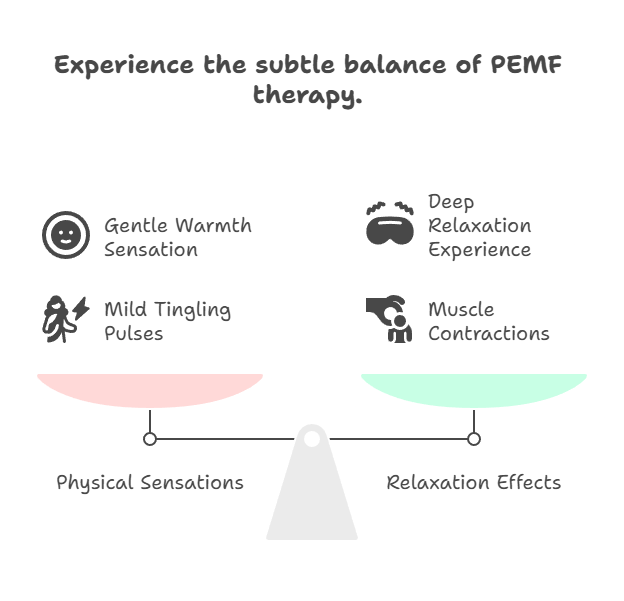
What Sensations Should You Expect During a PEMF Session?
While some people expect to feel a strong electrical or magnetic pull, the sensations from PEMF therapy are usually much more subtle. A survey of user experiences from Pulse PEMF reveals that the most common feelings are:
- A gentle, soothing warmth: This is often the result of increased circulation in the treated area.
- A mild tingling or pulsing: This is the direct sensation of the electromagnetic fields interacting with your cells.
- Small muscle contractions: In some cases, the muscles in the targeted area may gently contract in rhythm with the pulses.
- Deep relaxation: Many users report a profound sense of calm and relaxation, with some even falling asleep during their sessions.
Understanding What Your Sensations Mean
The sensations you experience during PEMF therapy are actually indicators of how the electromagnetic fields are interacting with your body's tissues:
Warmth indicates increased blood flow and circulation to the area. As the electromagnetic pulses stimulate vasodilation (widening of blood vessels), more warm blood flows through the tissue. This is a positive sign that nutrient delivery and waste removal are being enhanced.
Tingling or pulsing represents the direct interaction between electromagnetic fields and your nerve endings. This sensation occurs as the pulses stimulate ion channels in nerve cell membranes, temporarily changing their electrical potential. This is the therapy actively working at the cellular level.
Muscle twitches happen when the electromagnetic pulses are strong enough to cause motor neuron activation. This is completely normal and indicates that the field strength is sufficient to create measurable physiological effects. The rhythmic contractions can also help pump blood and lymphatic fluid through the tissue.
Relaxation and drowsiness occur because PEMF therapy influences your autonomic nervous system, shifting you toward parasympathetic (rest and digest) dominance. This is when healing occurs most effectively.
What If You Feel Nothing?
Here's an important truth that surprises many users: feeling nothing does not mean the therapy isn't working. In fact, approximately 40-50% of PEMF users report minimal or no sensation during treatment, yet they still experience significant therapeutic benefits.
Why does this happen?
Individual nerve sensitivity varies: Some people have less sensitive mechanoreceptors and nerve endings that simply don't register the subtle electromagnetic stimulation as strongly.
Deeper tissue treatment: When PEMF is working on deeper structures like bones, joints, or internal organs, you may not feel surface sensations even though cellular-level changes are occurring.
Lower frequency protocols: Certain therapeutic frequencies (especially those below 10 Hz) are extremely effective for healing but produce little to no sensation because they don't activate sensory nerve thresholds.
Cellular changes are microscopic: The most important effects—ATP production, ion exchange, protein synthesis—happen at scales far too small to produce conscious sensation.
Your body adapts: After several sessions, your nervous system may habituate to the electromagnetic pulses, causing reduced sensation even though the therapeutic effects continue.
The key is to judge effectiveness by outcomes (reduced pain, improved mobility, faster healing) rather than by sensations during treatment.
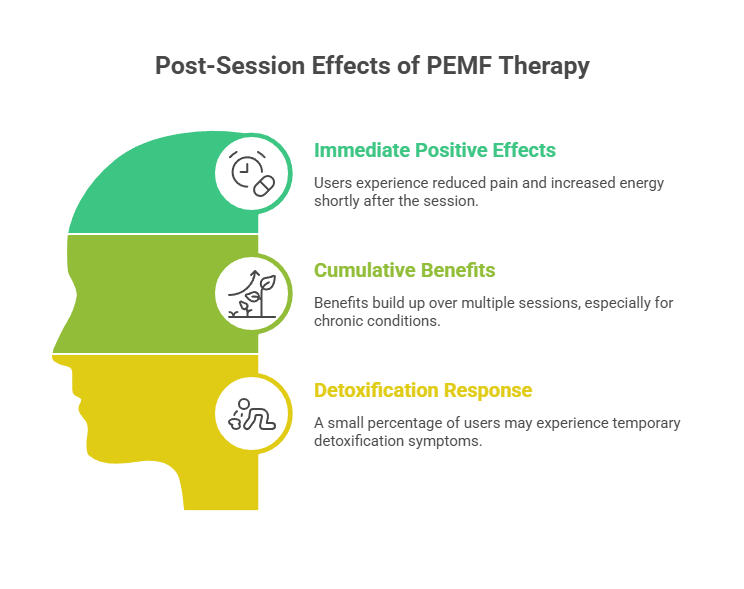
What Are the Post-Session Effects of PEMF Therapy?
The benefits of PEMF therapy often become more apparent after the session. Post-session outcomes, as documented by Hope Brain Center, can be categorized as follows:
Immediate Positive Effects
Many users feel an immediate sense of well-being, with reduced pain and increased energy levels. These effects can be measured for 6-8 hours post-session. The pain relief occurs because PEMF therapy has triggered the release of endorphins (your body's natural painkillers) and reduced inflammatory signaling in the affected area.
Cumulative Benefits
For chronic conditions, the benefits of PEMF therapy are often cumulative, building up over a series of sessions. Each treatment session builds upon the previous one, gradually restoring cellular function and tissue health. This is why consistency is crucial—sporadic treatments may provide temporary relief but won't produce lasting changes.
Detoxification Response
A small percentage of users (around 5%) may experience a temporary detoxification response, which can include mild headaches, fatigue, or nausea. These symptoms are a sign that the body is eliminating toxins and typically resolve within 24 hours. This occurs because improved circulation and cellular function accelerate the removal of metabolic waste products that have accumulated in tissues. If you experience these symptoms, reduce session duration and increase hydration.
Treatment Protocols and Session Guidelines
One of the most common questions from new PEMF users is: "How often and how long should I use it?" The answer depends on your specific condition and treatment goals.
General Protocol Guidelines
For Acute Conditions (recent injuries, post-surgical recovery, acute pain flare-ups):
- Session duration: 20-30 minutes
- Frequency: 2-3 times daily
- Intensity: Moderate to high (depending on tolerance)
- Duration of treatment plan: 2-4 weeks
- Expected results timeline: Improvement within 3-7 days
For Chronic Conditions (arthritis, chronic pain, long-standing inflammation):
- Session duration: 30-45 minutes
- Frequency: Once or twice daily
- Intensity: Start low, gradually increase
- Duration of treatment plan: 8-12 weeks minimum
- Expected results timeline: Noticeable improvement in 3-6 weeks
For General Wellness and Prevention:
- Session duration: 20-30 minutes
- Frequency: 3-5 times per week
- Intensity: Low to moderate
- Duration of treatment plan: Ongoing maintenance
- Expected results timeline: Improved energy and recovery within 2-3 weeks
For Athletic Performance and Recovery:
- Session duration: 15-20 minutes pre-workout, 30 minutes post-workout
- Frequency: Daily on training days
- Intensity: Moderate
- Duration of treatment plan: Ongoing during training periods
- Expected results timeline: Reduced soreness within 1-2 weeks
Adjusting Your Protocol
When to increase intensity: If after 2 weeks you're experiencing minimal benefits and tolerating sessions well, gradually increase intensity by 10-20%.
When to reduce intensity: If you experience significant fatigue, headaches, or aggravation of symptoms, reduce intensity or session duration by half.
When to increase frequency: For stubborn chronic conditions that are showing slow but steady improvement, adding an extra daily session can accelerate progress.
When to take breaks: If you experience overuse symptoms (persistent fatigue, irritability, sleep disruption), take 2-3 days off to allow your body to integrate the changes.
Timing Considerations
Best time of day: Morning or early afternoon sessions tend to be energizing, while evening sessions are more relaxing. Avoid intense sessions within 2 hours of bedtime if you're sensitive to energy shifts.
Before or after meals: Either is fine, though some users prefer treatment on an empty stomach to avoid any digestive discomfort from muscle contractions.
Hydration: Drink 8-16 oz of water before and after each session to support the detoxification process and enhance cellular function.
Condition-Specific Applications and Timelines
Understanding what to expect for your specific condition helps set realistic expectations and maintain consistency with treatment.
Bone Healing (Fractures, Non-Union Bones)
PEMF therapy has FDA approval for bone healing since 1979, with an 80% success rate for non-union fractures.
Mechanism: Electromagnetic pulses stimulate osteoblasts (bone-forming cells) and increase calcium deposition in the fracture site. They also enhance blood vessel formation (angiogenesis) which is crucial for delivering nutrients to healing bone.
Typical protocol: 3-4 hours daily at 15-30 Hz
Expected timeline:
- Weeks 1-2: Minimal visible changes, cellular activity increasing
- Weeks 3-4: Early signs of bone callus formation on imaging
- Weeks 6-8: Significant bone bridging visible on X-rays
- Weeks 12-16: Completion of union in most cases
Success indicators: Reduced pain at fracture site, ability to bear more weight, radiographic evidence of healing
Osteoarthritis
Multiple studies show PEMF therapy reduces pain and improves function in osteoarthritis patients.
Mechanism: Reduces inflammatory cytokines in joint fluid, stimulates chondrocyte (cartilage cell) activity, and improves synovial fluid circulation.
Typical protocol: 30-45 minutes daily at 10-50 Hz
Expected timeline:
- Week 1-2: Slight reduction in stiffness
- Week 3-4: Noticeable pain reduction (20-30%)
- Week 6-8: Improved mobility and function (30-40% improvement)
- Week 12+: Maximum benefits achieved, maintenance begins
Success indicators: Reduced morning stiffness, decreased pain during activity, improved range of motion, reduced need for pain medication
Chronic Lower Back Pain
Research shows PEMF can significantly reduce pain and improve function in chronic lower back pain sufferers.
Mechanism: Reduces muscle spasm, decreases inflammation in intervertebral discs and facet joints, improves circulation to spinal tissues.
Typical protocol: 30-40 minutes daily at 10-25 Hz applied to lower back
Expected timeline:
- Week 1-2: Reduced muscle tension and spasm
- Week 3-4: 25-40% pain reduction
- Week 6-8: 50-60% improvement in pain and function
- Week 12+: Continued improvement and prevention of flare-ups
Success indicators: Decreased pain intensity, improved ability to perform daily activities, reduced reliance on pain medication, better sleep quality
Soft Tissue Injuries (Sprains, Strains, Tendinitis)
PEMF accelerates soft tissue repair by enhancing cellular metabolism and reducing inflammation.
Mechanism: Increases fibroblast activity (cells that produce collagen), reduces edema, enhances angiogenesis.
Typical protocol: 20-30 minutes 2-3 times daily at 15-50 Hz
Expected timeline:
- Days 1-3: Reduced swelling and initial pain relief
- Week 1: Significant reduction in inflammation
- Week 2-3: Improved tissue integrity and function
- Week 4-6: Near-complete or complete healing in most cases
Success indicators: Reduced swelling, improved range of motion, decreased pain with activity, return to normal function
Post-Surgical Recovery
PEMF therapy can accelerate recovery after various surgical procedures.
Mechanism: Reduces post-operative inflammation and edema, accelerates wound healing, reduces scar tissue formation.
Typical protocol: 20-30 minutes 2-3 times daily at 10-30 Hz, starting 24-48 hours post-surgery (with physician approval)
Expected timeline:
- Days 1-5: Reduced swelling and bruising
- Week 1-2: Faster incision healing, reduced pain
- Week 3-4: Improved mobility and function
- Week 6-8: Accelerated return to normal activities
Success indicators: Minimal swelling, clean wound healing, reduced scar tissue, faster functional recovery
Fibromyalgia
Emerging evidence suggests PEMF may help manage fibromyalgia symptoms.
Mechanism: Modulates pain signaling in the central nervous system, improves sleep quality, reduces systemic inflammation.
Typical protocol: 30-40 minutes daily, full-body mat at 3-15 Hz
Expected timeline:
- Week 1-3: Improved sleep quality
- Week 4-6: Gradual reduction in pain intensity
- Week 8-12: Improved energy levels and reduced fatigue
- Week 16+: Optimal symptom management achieved
Success indicators: Better sleep, reduced widespread pain, improved energy levels, enhanced quality of life
Anxiety and Depression
Transcranial PEMF therapy shows promise for mental health applications.
Mechanism: Modulates neurotransmitter activity, influences brain wave patterns, may affect neuroplasticity.
Typical protocol: 20-30 minutes daily at 0.5-10 Hz, using transcranial applicator or full-body mat
Expected timeline:
- Week 1-2: Subtle mood improvements
- Week 3-4: Noticeable reduction in anxiety or depressive symptoms
- Week 6-8: Significant improvement in overall mental state
- Week 12+: Sustained benefits with maintenance protocol
Success indicators: Improved mood, reduced anxiety, better stress management, improved sleep
Comparing PEMF with Other Therapies
Understanding how PEMF compares to alternative treatments helps you make informed decisions about your healthcare approach.
PEMF vs. Pain Medications
Pain Medications (NSAIDs, Opioids):
- Rapid symptom relief (30-60 minutes)
- Addresses symptoms, not underlying causes
- Risk of side effects (GI issues, addiction potential, organ damage)
- Ongoing costs
- May mask injury, allowing further damage
PEMF Therapy:
- Gradual but lasting relief (days to weeks)
- Addresses root causes (inflammation, cellular dysfunction)
- Minimal to no side effects
- One-time device cost for home use
- Promotes actual healing
Best used together when: Acute severe pain requires immediate relief while PEMF works on healing the underlying tissue damage. Many users can reduce or eliminate medication use after 4-8 weeks of consistent PEMF therapy.
PEMF vs. Physical Therapy
Physical Therapy:
- Active rehabilitation approach
- Addresses mechanical dysfunction and weakness
- Requires effort and can initially increase discomfort
- Typically covered by insurance
- Time-limited by insurance (usually 8-12 visits)
PEMF Therapy:
- Passive treatment approach
- Addresses cellular and tissue-level dysfunction
- Comfortable and relaxing
- Usually not covered by insurance (except specific FDA approvals)
- Unlimited use with home device
Best used together when: Physical therapy provides essential movement patterns and strength training, while PEMF accelerates tissue healing and reduces pain, making PT exercises more tolerable and effective.
PEMF vs. TENS (Transcutaneous Electrical Nerve Stimulation)
TENS:
- Surface-level electrical stimulation
- Blocks pain signals via gate control theory
- Immediate but temporary relief
- No healing effect
- Requires electrode placement on skin
PEMF:
- Deep-penetrating electromagnetic fields
- Promotes cellular healing and reduces inflammation
- Gradual but lasting benefits
- Actual tissue repair
- No direct skin contact needed
Best used together when: TENS can provide immediate pain relief for acute flare-ups while maintaining daily PEMF therapy for long-term healing.
PEMF vs. Red Light/Infrared Therapy
Red Light/Infrared Therapy:
- Photonic energy stimulates mitochondria
- Shallow penetration (typically 5-10mm)
- Excellent for skin, wounds, superficial tissues
- Requires direct light exposure to bare skin
PEMF:
- Electromagnetic energy stimulates cells
- Deep penetration (can reach organs, deep tissues, bones)
- Effective for internal and deep structures
- Works through clothing
Best used together when: Combining both creates synergistic effects—red light for surface tissues and skin, PEMF for deeper structures. Many sports medicine clinics use this combination.
PEMF vs. Ultrasound Therapy
Ultrasound Therapy:
- Sound waves create mechanical vibration
- Good for localized soft tissue injuries
- Requires gel medium and direct skin contact
- Typically delivered by trained professional
PEMF:
- Electromagnetic waves create electrical effects
- Effective for wide range of tissues including bone
- No gel or direct contact needed
- Easily self-administered
Best used together when: Some stubborn localized soft tissue injuries may benefit from professional ultrasound treatments supplemented by daily home PEMF therapy.
Understanding PEMF Device Technology
Choosing the right device requires understanding what the technical specifications actually mean for your therapeutic goals.
Frequency Explained
Frequency (measured in Hertz, Hz) refers to how many electromagnetic pulses occur per second. Different frequencies produce different biological effects:
0.5-5 Hz (Ultra-Low Frequency):
- Promotes deep relaxation and sleep
- Mimics delta brain waves
- Excellent for stress reduction and meditation
- Used for anxiety, insomnia, mental health
5-10 Hz (Low Frequency):
- Promotes healing and tissue repair
- Mimics theta and alpha brain waves
- Optimal for chronic pain and inflammation
- Used for arthritis, fibromyalgia, chronic conditions
10-30 Hz (Mid Frequency):
- Enhances circulation and bone healing
- Balances relaxation and stimulation
- Used for fractures, post-surgical healing
- General wellness applications
30-100 Hz (Higher Frequency):
- Stimulates cellular energy production
- More energizing effect
- Used for acute injuries and performance
- Athletic recovery and performance enhancement
Practical implication: A device with adjustable frequency (1-100 Hz) provides maximum versatility for different conditions and times of day.
Intensity (Gauss or Tesla)
Intensity measures the strength of the magnetic field. 1 Tesla = 10,000 Gauss. Most PEMF devices range from 0.1 to 5,000 Gauss.
Low Intensity (0.1-10 Gauss):
- Gentler cellular stimulation
- Suitable for sensitive individuals
- Effective for wellness and prevention
- Minimal to no sensation
- Examples: Earth's magnetic field is 0.5 Gauss
Medium Intensity (10-100 Gauss):
- Most versatile range for therapy
- Good balance of effectiveness and comfort
- Suitable for most conditions
- Noticeable but comfortable sensation
- Most home devices operate in this range
High Intensity (100-5,000+ Gauss):
- Powerful cellular stimulation
- Can produce muscle contractions
- Used for stubborn conditions and deep tissues
- May be uncomfortable for some
- Professional/clinical devices often use this range
Practical implication: Higher isn't always better. Start with moderate intensity and increase only if needed. Some conditions (like sleep and relaxation) respond better to lower intensities.
Waveform Matters
The shape of the electromagnetic pulse affects how it interacts with your tissues.
Sine Wave:
- Smooth, rounded waveform
- Gentle and comfortable
- Good for wellness and sensitive conditions
- Produces less sensation
- Mimics natural biological rhythms
Square Wave:
- Abrupt on/off pattern
- More stimulating effect
- Better for stubborn conditions
- Produces more noticeable sensation
- Stronger muscle contraction effect
Sawtooth Wave:
- Gradual rise, sudden drop
- Combines aspects of both
- Versatile for various conditions
- Moderate sensation
- Good all-purpose waveform
Complex/Bio-identical Waveforms:
- Multiple frequencies combined
- Mimics Earth's natural magnetic fields
- Claimed to be more "natural" and effective
- Used by premium devices
- Higher cost
Practical implication: For most users, sawtooth or complex waveforms offer the best combination of effectiveness and comfort. Sine waves are best for highly sensitive individuals.
Application Method: Mat vs. Pad vs. Probe
Full-Body Mats:
- Large surface area (typically 60" x 24")
- Treats entire body simultaneously
- Best for: Systemic conditions, general wellness, sleep, fibromyalgia
- Pros: Convenient, treats multiple areas at once
- Cons: Less focused intensity on specific problem areas
- Price range: $1,000-$8,000
Localized Pads/Applicators:
- Smaller targeted applicators (6" x 8" to 18" x 24")
- Focused treatment on specific body part
- Best for: Joint pain, injuries, localized pain
- Pros: Higher intensity to specific area, portable
- Cons: Can only treat one area at a time
- Price range: $500-$3,000
Probe/Spot Applicators:
- Small pinpointed applicators (pen-sized to baseball-sized)
- Very focused high-intensity treatment
- Best for: Trigger points, small injuries, acupuncture points
- Pros: Highest intensity to tiny area, very portable
- Cons: Time-consuming for larger areas
- Price range: $300-$1,500
Practical implication: Many users benefit from having both a full-body mat for general wellness and maintenance, plus a localized pad or probe for specific problem areas.
Red Flags for Poor-Quality Devices
Not all PEMF devices are created equal. Watch out for:
- No published specifications: Legitimate manufacturers provide exact frequency ranges, intensity levels, and waveforms
- Unrealistic claims: "Cures cancer," "Fixes all diseases," "Miracle cure"—these are marketing red flags
- No research citations: Quality manufacturers reference peer-reviewed studies
- Extremely low prices: Effective PEMF devices require quality components; beware of $100-200 devices
- Proprietary technology without explanation: Legitimate innovation can be explained in scientific terms
- No return policy or warranty: Quality devices come with at least 30-day returns and 1-3 year warranties
- Pressure sales tactics: Reputable companies educate rather than pressure
Cost-Benefit Analysis
Understanding the financial investment helps you make an informed purchasing decision.
Clinical PEMF Sessions
Professional clinic treatments:
- Cost per session: $50-$150
- Typical treatment plan: 10-20 sessions
- Total cost: $500-$3,000
- Pros: Professional guidance, higher-intensity devices, no equipment purchase
- Cons: Ongoing costs, travel time, limited availability
Home PEMF Devices
Entry-level devices ($300-$1,000):
- Basic functionality, limited adjustability
- Suitable for: Mild conditions, wellness, single-user
- Break-even vs. clinic: 3-10 sessions
Mid-range devices ($1,000-$3,000):
- Good adjustability, multiple applicators
- Suitable for: Most chronic conditions, family use
- Break-even vs. clinic: 10-30 sessions
Professional-grade home devices ($3,000-$10,000):
- Clinical-quality, maximum adjustability
- Suitable for: Serious conditions, multiple users, practitioner use
- Break-even vs. clinic: 30-100 sessions
Return on Investment Calculation
Consider a user with chronic knee arthritis:
Option 1: Clinical treatment only
- 20 sessions at $100 each = $2,000
- Results last 3-6 months
- Annual cost: $4,000-$8,000 for ongoing maintenance
Option 2: Mid-range home device
- Initial cost: $2,000
- Unlimited use for 5+ years
- Total 5-year cost: $2,000 (plus electricity, negligible)
- 5-year savings: $18,000-$38,000
Additional value considerations:
- Convenience (no travel time or appointments)
- Flexibility (use anytime, as often as needed)
- Family use (multiple people can benefit)
- Treatment of new issues as they arise
- Resale value (quality devices retain 40-60% value)
Insurance and Reimbursement
Currently covered: Most insurance plans cover PEMF only for FDA-approved applications like non-union bone fractures when prescribed by a physician.
Reimbursement process:
- Obtain prescription from physician for specific FDA-approved condition
- Purchase device and keep all receipts
- Submit claim with prescription, receipt, and letter of medical necessity
- Follow up persistently (initial denials are common)
HSA/FSA eligibility: PEMF devices may be purchased with pre-tax Health Savings Account or Flexible Spending Account funds if you have a letter of medical necessity from your physician. Check with your HSA/FSA administrator.
Rental options: Some suppliers offer rent-to-own programs:
- Rent for 1-3 months at $200-$400/month
- Apply rental payments toward purchase
- Test before committing to full purchase price
- Useful for trial period or short-term needs
Your PEMF Journey: Week-by-Week Expectations
Understanding the typical progression helps you stay consistent even when immediate results aren't dramatic.
Week 1: Adaptation Phase
What's happening: Your body is adapting to the electromagnetic stimulation. Cells are beginning to respond with increased ATP production and ion exchange.
What you might notice:
- Improved sleep quality (most common first benefit)
- Slight increase in energy or slight fatigue (detox response)
- Minimal pain reduction, if any
- Possible mild detox symptoms (5% of users)
What to do:
- Stick to recommended protocols consistently
- Stay well-hydrated
- Don't judge effectiveness yet—it's too early
- Keep a simple journal of symptoms
Weeks 2-3: Early Changes
What's happening: Cellular improvements are accumulating. Inflammation is beginning to decrease. Blood flow to affected areas is improving.
What you might notice:
- 10-20% reduction in pain or discomfort
- Improved mobility or flexibility
- Better energy levels stabilizing
- Reduced morning stiffness (if applicable)
What to do:
- Continue consistent daily use
- You may be tempted to skip sessions—don't!
- Consider adding a second daily session if progress is slow
- Note improvements in your journal
Weeks 4-6: Noticeable Improvement
What's happening: Tissue-level changes are becoming significant. Inflammation markers are substantially reduced. Healing processes are well-established.
What you might notice:
- 30-50% reduction in symptoms
- Activities that were painful becoming easier
- Reduced need for pain medication
- Friends and family may comment on your improvement
What to do:
- Continue protocols without interruption
- This is when many people plateau temporarily—push through
- May need to adjust intensity or frequency
- Celebrate your progress!
Weeks 8-12: Significant Benefits
What's happening: Major tissue repair and cellular regeneration is occurring. New blood vessels have formed. Chronic inflammation patterns are breaking down.
What you might notice:
- 50-70% improvement in primary complaint
- Return to activities you'd given up
- Substantially reduced medication use
- Improved overall well-being
What to do:
- Begin transitioning to maintenance protocol
- Consider reducing frequency to 5 days/week if desired
- Don't stop abruptly—taper down gradually
Beyond 12 Weeks: Maintenance Phase
What's happening: Tissue healing is largely complete. You're now maintaining optimal cellular function and preventing future deterioration.
What you might notice:
- Stable, lasting improvement
- Continued gradual gains in some cases
- Quick recovery if you experience setbacks
- General wellness benefits
What to do:
- Reduce to 3-5 sessions per week for maintenance
- Continue indefinitely for chronic conditions
- Increase frequency temporarily if symptoms flare
- Use preventatively before/after stressful activities
Normal Plateaus and Setbacks
Healing isn't linear. You may experience:
Temporary plateaus (1-2 weeks with no change):
- Normal part of healing process
- Body is consolidating gains
- Continue your protocol consistently
- Don't increase intensity dramatically
Brief setbacks (symptoms temporarily worsen):
- May occur around weeks 3-4 or 8-9
- Often precedes breakthrough improvement
- Can be triggered by overdoing activities
- Reduce activity, continue PEMF, stay patient
Flare-ups (sudden symptom increase):
- Usually due to overuse, weather changes, stress
- Temporarily increase PEMF frequency
- Return to maintenance once settled
- This is when owning a device proves valuable
Tracking Your Progress
Objective tracking prevents discouragement and helps optimize your protocol.
What to Track
Pain levels: Rate 0-10 daily, note location and quality
- Track at the same time each day (morning is most consistent)
- Note what triggers increases or decreases
Function metrics: Choose 2-3 activities affected by your condition
- Knee arthritis: "Walked X minutes before pain," "Climbed X stairs without holding rail"
- Back pain: "Sat for X minutes comfortably," "Bent and touched within X inches of floor"
- Fibromyalgia: "Energy level 1-10," "Quality activities completed today"
Medication use: Track dosage and frequency
- Note any reductions
- Coordinate with physician for prescription medications
Sleep quality: Rate 1-10 and note hours slept
- Sleep improvement often precedes pain reduction
Overall well-being: Weekly rating of general quality of life
Simple Tracking Method
Create a simple weekly chart:
Week 1: [Date]
Pain Level (0-10): Morning ___ Evening ___
Function: [Activity] ___
Medication: ___
Sleep (0-10): ___
Notes: ___
When to Consult a Professional
Seek medical advice if:
- No improvement after 4-6 weeks of consistent use
- Symptoms worsen significantly
- New symptoms develop
- You want to reduce prescription medications
- Uncertainty about proper device settings
Consider working with a PEMF-knowledgeable practitioner if:
- Complex or multiple conditions
- Previous treatments have failed
- Want optimized protocols
- Need help interpreting progress
Expanded Safety and Contraindications
Absolute Contraindications (Do Not Use)
Active pacemaker or defibrillator: Electromagnetic fields can interfere with device programming and function. This is a strict contraindication.
Pregnancy: While no harm has been documented, insufficient research exists on fetal effects. Avoid use during pregnancy out of abundant caution.
Active bleeding or hemorrhage: PEMF increases circulation and could worsen bleeding.
Acute infections with fever: May accelerate bacterial growth or spread of infection.
Relative Contraindications (Use with Caution and Medical Supervision)
Epilepsy or seizure disorders: Low frequencies (especially under 10 Hz) may potentially trigger seizures in susceptible individuals. If cleared by neurologist, start with higher frequencies (above 20 Hz) and avoid transcranial application.
Active cancer: Controversial area. Some research suggests PEMF may help certain cancers, while theoretical concerns exist about stimulating cancer cell growth. Always consult oncologist. Generally considered safer after completion of active treatment.
Organ transplant recipients: Immune modulation effects may interact with immunosuppressive medications. Requires physician approval.
Hyperthyroid conditions: Electromagnetic stimulation of thyroid area may increase hormone production.
Common Implants: What's Actually Safe?
Generally SAFE (confirmed by manufacturers and clinical use):
- Titanium joint replacements (hips, knees)
- Dental implants and crowns
- Surgical screws and plates (non-electronic)
- Intrauterine devices (IUDs) - though avoid direct pelvic application
- Breast implants
- Surgical mesh
REQUIRES CAUTION:
- Insulin pumps: Remove during treatment or avoid treatment area
- Hearing aids/cochlear implants: Remove during treatment
- Spinal cord stimulators: Consult with device manufacturer
- Deep brain stimulators: Avoid transcranial PEMF
Practical approach: If you have any implant, start with low intensity away from the implant site and gradually increase if no issues occur.
Medication Interactions
Blood thinners (Warfarin, aspirin, etc.): PEMF may enhance circulation and bruising tendency. Monitor for increased bruising; no dose adjustment typically needed, but inform your physician.
Chemotherapy drugs: Timing matters—some practitioners recommend PEMF between chemotherapy cycles to aid recovery, not during active treatment. Always coordinate with oncologist.
Immunosuppressants: PEMF's immune-modulating effects may theoretically interfere. Requires medical supervision and monitoring.
Supplements that increase circulation (ginkgo, fish oil): May have additive effects; monitor for bruising.
Special Populations
Children: Generally safe for children with appropriate adult supervision. Use lower intensities and shorter sessions (10-15 minutes). Excellent for sports injuries, growing pains, and bone conditions.
Elderly: Usually well-tolerated. May need longer treatment periods for similar results. Watch for detox responses; start with lower intensity.
Post-surgical patients: Can usually begin 24-48 hours after surgery with physician approval. Avoid placing directly over fresh incisions. Excellent for reducing swelling and accelerating healing.
Troubleshooting Common Concerns
"I've been using PEMF for 3 weeks and feel no improvement"
Checklist:
- Are you using adequate intensity? Try increasing by 20%
- Are you consistent? Missing sessions prevents cumulative effects
- Is your frequency appropriate for your condition? Lower (5-15 Hz) for chronic conditions
- Are sessions long enough? Minimum 20 minutes
- Are you treating the right area? Inflammation may refer pain elsewhere
- Is your device functioning properly? Check with manufacturer
- Do you have realistic expectations for your specific condition? Some take 6-8 weeks
Actions: Increase to twice daily sessions, ensure proper applicator placement, consider professional consultation.
"I felt great initially but now the benefits have plateaued"
This is normal around weeks 3-4 and again at weeks 7-9.
Why it happens: Your body is consolidating healing gains. Think of it like building muscle—you don't grow during workouts, you grow during rest periods.
Actions:
- Continue your protocol without changes for another 2 weeks
- Ensure adequate sleep and nutrition to support healing
- Consider adding complementary therapy (stretching, hydration, stress reduction)
- Don't increase intensity dramatically; stay the course
"I feel worse after sessions - tired, headachy, irritable"
You're experiencing a detoxification response (5% of users).
Why it happens: Improved cellular function and circulation release accumulated metabolic waste and toxins into your bloodstream faster than your elimination systems can clear them.
Actions:
- Reduce session duration by half
- Reduce frequency to every other day temporarily
- Dramatically increase water intake (add 32-64 oz daily)
- Support detox pathways: gentle exercise, sauna, adequate sleep
- Add electrolytes to water
- Consider liver support supplements (milk thistle, NAC) with medical approval
- Symptoms typically resolve in 3-7 days
"My pain moves around to different areas"
This is actually a positive sign and quite common.
Why it happens: As you heal the primary problem area, your body's awareness shifts to other areas of dysfunction that were masked by the more severe pain.
Actions:
- Continue treating original area
- Add treatment to new area as well
- Consider using full-body mat to address multiple areas
- This typically resolves as overall healing progresses
"I fell asleep during treatment and went over the recommended time"
Generally not a problem unless you experience overuse symptoms.
Why it's usually fine: PEMF is very safe; overuse rarely causes anything worse than temporary fatigue.
Actions:
- Monitor how you feel over next 24 hours
- If fatigue or detox symptoms occur, skip next 1-2 sessions
- Consider setting an alarm for future sessions
- Some devices have auto-shutoff timers
"I'm not sure if I'm placing the applicator correctly"
Placement matters but there's more forgiveness than you might think.
General rules:
- For joint pain: Place directly over the joint
- For muscle pain: Over the painful muscle belly
- For bone healing: Directly over fracture site
- For organ issues: Over the organ (electromagnetic fields penetrate deeply)
- For systemic issues: Full-body mat or rotate treatment areas
Actions:
- Electromagnetic fields spread in all directions; being within 2-3 inches of ideal is usually fine
- If unsure, treat a larger area or use full-body mat
- Some experimentation is okay—note what placement gives best results
Advanced Optimization Strategies
Once you're comfortable with basic PEMF use, these strategies can enhance results.
Stacking with Other Therapies
PEMF + Red Light Therapy: Use red light first (15-20 minutes) to activate mitochondria, immediately followed by PEMF to enhance cellular energy utilization. Synergistic for wound healing, skin conditions, and muscle recovery.
PEMF + Grounding/Earthing: Use grounding mat while doing PEMF therapy to enhance electron transfer and reduce inflammation. Anecdotal reports suggest improved relaxation and results.
PEMF + Stretching: Do gentle stretching immediately after PEMF session while tissues are warm and circulation is enhanced. Improves flexibility gains.
PEMF + Ice or Heat: Use ice after PEMF for acute injuries (PEMF increases circulation, ice controls excessive swelling). Use heat before PEMF for chronic conditions to prepare tissues.
PEMF + Supplementation: Consider supplements that support cellular energy:
- CoQ10 (100-200mg) - supports mitochondrial function
- Magnesium (400-600mg) - cofactor for ATP production
- B-vitamins - support energy metabolism
- Omega-3s - reduce inflammation, enhance cell membrane function
Frequency Cycling
Instead of using one frequency continuously, cycle through different frequencies within a session or across days:
Within-session cycling:
- Start with 10 Hz for 10 minutes (healing)
- Increase to 30 Hz for 15 minutes (circulation)
- End with 5 Hz for 10 minutes (relaxation)
Across-day cycling:
- Monday/Wednesday/Friday: Lower frequencies (5-15 Hz) for deep healing
- Tuesday/Thursday/Saturday: Higher frequencies (20-50 Hz) for energy and recovery
- Sunday: Ultra-low (1-3 Hz) for deep relaxation and integration
Theory: Prevents cellular adaptation and stimulates different physiological processes.
Pulsing Protocols
Some advanced users alternate between treatment days and rest days:
Example: 5 days on, 2 days off
Theory: Rest days allow the body to integrate healing changes without constant stimulation. Some users report this prevents plateaus.
Best for: Chronic conditions after initial 4-6 week intensive period.
Time-of-Day Optimization
Morning sessions (6-10 AM):
- Use higher frequencies (20-50 Hz)
- Shorter duration (15-20 minutes)
- Energizing effect to start day
Afternoon sessions (2-5 PM):
- Mid-range frequencies (10-25 Hz)
- Standard duration (20-30 minutes)
- Therapeutic focus
Evening sessions (7-9 PM):
- Lower frequencies (1-10 Hz)
- Longer duration possible (30-45 minutes)
- Relaxation and sleep preparation
- Avoid high frequencies/intensity within 2 hours of bedtime
The Science of "Feeling Nothing"
Let's go deeper into why absence of sensation doesn't mean absence of effect.
What You Can't Feel But Is Happening
Mitochondrial changes: Your mitochondria are producing 20-40% more ATP during and after treatment. This happens at a molecular scale—completely imperceptible but measurable with laboratory tests.
Ion channel activation: Calcium, sodium, and potassium ions are moving across cell membranes at increased rates. Each ion movement is measured in billionths of meters—far below sensory perception.
Gene expression changes: PEMF therapy can upregulate or downregulate specific genes involved in inflammation, healing, and cell survival. This happens at the DNA level in the cell nucleus.
Nitric oxide production: Increased nitric oxide synthesis in blood vessel walls causes vasodilation. Unless it's dramatic enough to create noticeable warmth, you won't feel individual blood vessels dilating.
Cytokine modulation: Pro-inflammatory cytokines like IL-6 and TNF-alpha decrease while anti-inflammatory cytokines increase. These molecular signals are invisible to sensation.
Measurable Markers Even When You Feel Nothing
Thermography: Infrared imaging can show increased heat/circulation in treated areas even when you don't feel warmth.
Blood flow ultrasound: Doppler ultrasound demonstrates increased blood velocity in treated tissues.
Inflammation markers: Blood tests can show reduced C-reactive protein and ESR (erythrocyte sedimentation rate).
Range of motion: Objective goniometer measurements often show improved joint angles even when pain levels seem unchanged.
Grip strength: Dynamometer testing may reveal increased strength before subjective improvement is noticed.
Sleep studies: Polysomnography can document improved deep sleep percentages even if you don't consciously notice better sleep.
The Psychological Challenge
Humans are wired to trust sensory feedback. When a treatment produces no immediate sensation, our brains question whether it's working. This is why:
Placebo effect is minimal with PEMF: Studies show PEMF works similarly in blinded trials where patients don't know if they're receiving treatment. The benefits aren't dependent on belief.
Objective measures trump sensation: Focus on functional improvements (stairs climbed, hours sitting comfortably, medication reduction) rather than what you feel during treatment.
Time-delayed awareness: You often don't realize improvement until you attempt an activity that used to be painful and notice it no longer hurts. Healing happened before you became consciously aware.
What Do the Experts Say About PEMF Therapy?
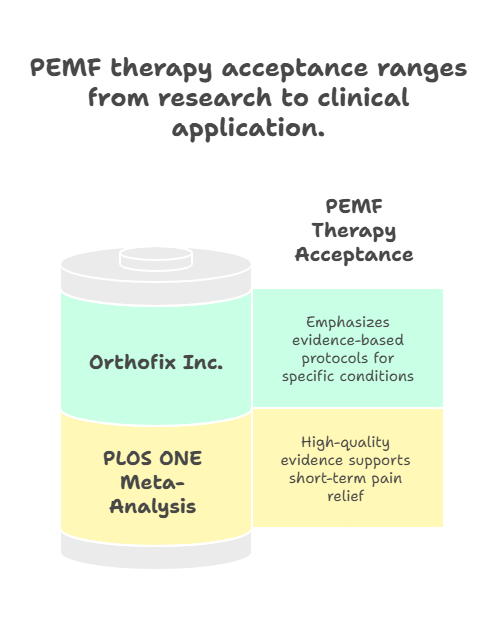
The medical community's confidence in PEMF therapy is growing, backed by a significant body of research. A 2024 meta-analysis published in PLOS ONE found high-quality evidence supporting the use of PEMF for short-term pain relief and functional improvement in patients with shoulder impingement syndrome.
Experts from Orthofix Inc., a leading manufacturer of PEMF devices, emphasize the importance of using evidence-based protocols. They state, "Optimization of PEMFs for improvement in efficacy for current indications, in addition to the expansion into new indications, is not trivial... necessitating the need for preclinical studies." This highlights the importance of using devices with proven parameters for specific conditions.
Current Research Landscape
Established evidence (multiple high-quality studies):
- Bone healing and non-union fractures
- Osteoarthritis pain and function
- Post-surgical pain and swelling
- Chronic lower back pain
- Soft tissue injury recovery
Emerging evidence (promising but needs more research):
- Depression and anxiety
- Fibromyalgia
- Migraine headaches
- Diabetic neuropathy
- Sports performance enhancement
Under investigation (early research, controversial):
- Alzheimer's disease and dementia
- Parkinson's disease
- Stroke recovery
- Autism spectrum disorders
- Cancer support (highly controversial)
What Researchers Are Saying
The consensus among PEMF researchers emphasizes several key points:
Parameters matter: Not all PEMF is equal. The specific frequency, intensity, waveform, and duration must be matched to the condition being treated.
Quality studies are increasing: Early PEMF research was often poorly designed. Modern studies using proper controls and blinding are showing more consistent positive results.
Mechanisms are being clarified: We're moving beyond "it works but we don't know why" to understanding specific cellular and molecular mechanisms.
Safety profile is excellent: Across thousands of patients in clinical trials, serious adverse events are virtually non-existent.
Integration not replacement: Most researchers view PEMF as complementary to, not a replacement for, conventional medical care.
How Do I Choose a PEMF Device?
The PEMF device market offers a wide range of options, from budget-friendly portable units to professional-grade clinical systems. When choosing a device, consider the following:
Figure 1: PEMF Device Price Comparison across Popular Models in 2025
Key Selection Criteria
Frequency and Intensity: Different frequencies and intensities are used for different therapeutic purposes. A device that offers a range of settings will be more versatile. Look for:
- Frequency range: 1-100 Hz minimum for versatility
- Adjustable intensity: At least 3-5 intensity levels
- Ability to fine-tune settings for your specific condition
Waveform: The shape of the electromagnetic wave can influence its therapeutic effects. Common waveforms include sine, square, and sawtooth waves. Sawtooth and complex waveforms offer the best balance for most users.
Application Area: Do you need a device for targeted treatment of a specific area, or a full-body mat for general wellness?
- Single condition (knee arthritis): Localized pad may be sufficient
- Multiple conditions or systemic issues: Full-body mat recommended
- Both: Look for systems that include multiple applicators
Price: Prices can range from a few hundred dollars to several thousand. It's important to find a device that fits your budget and meets your therapeutic needs.
- Budget ($300-$1,000): Entry-level, limited features
- Mid-range ($1,000-$3,000): Best value for most users
- Professional ($3,000-$10,000): Maximum features and power
Recommended Device Features
Must-have features:
- Adjustable frequency (minimum 1-50 Hz range)
- Adjustable intensity (at least 3 levels)
- Auto-shutoff timer
- Clear user interface
- At least 1-year warranty
- Published specifications
Nice-to-have features:
- Pre-programmed protocols for specific conditions
- Multiple applicators included
- Frequency range up to 100 Hz
- USB or app connectivity for tracking
- 30-day money-back guarantee
- 2-3 year warranty
Luxury features (not necessary but valuable):
- Bio-feedback sensors
- Frequency scanning modes
- Professional-grade intensity (1000+ Gauss)
- Multiple simultaneous outputs
- Lifetime warranty
Questions to Ask Before Buying
- What specific condition am I treating? Match device capabilities to your needs.
- How many people will use it? Family use justifies higher investment.
- Do I need portability? Travel frequently? Prioritize compact, lightweight options.
- What's my budget? Don't overextend, but don't choose solely on price—a $500 device that doesn't work is more expensive than a $2,000 device that does.
- Is there a trial period? Reputable companies offer 30-60 day returns.
- What support is included? Look for educational resources, customer service, and protocol guidance.
- What do verified reviews say? Look beyond manufacturer websites to independent reviews.
What is the Future of PEMF Therapy?
The future of PEMF therapy looks bright. The global market for PEMF devices is projected to continue its strong growth, driven by an aging population, an increasing prevalence of chronic diseases, and a growing demand for non-invasive treatment options.
Figure 2: Global PEMF Therapy Device Market Growth Projection (2022-2033)
We can expect to see continued research into new applications for PEMF therapy, as well as the development of more sophisticated and user-friendly devices.
Emerging Trends
Artificial Intelligence integration: Future devices may use AI to analyze your response and automatically adjust protocols for optimal results.
Wearable PEMF: Smaller, more powerful devices that can be worn during daily activities rather than requiring dedicated treatment time.
Combination devices: Integration of PEMF with red light therapy, heat therapy, and other modalities in single units.
Targeted frequency delivery: More sophisticated understanding of which frequencies work best for specific conditions at specific stages of healing.
Personalized protocols: Genetic testing may eventually reveal which PEMF parameters work best for your individual biology.
Brain health applications: Expanding research into Alzheimer's, Parkinson's, TBI, and cognitive enhancement.
Cellular senescence: Research into using PEMF to address aging at the cellular level by influencing senescent cell behavior.
FAQ Section
Q: Can you use PEMF therapy too much?
A: While PEMF therapy is generally safe, it's important to follow the recommended treatment protocols. Overuse could potentially lead to a more pronounced detoxification response. Most home-use devices have built-in timers to prevent overuse. Signs of overuse include persistent fatigue, irritability, headaches, or sleep disruption. If you experience these, reduce frequency or duration for several days.
Q: How long does it take to see results from PEMF therapy?
A: The time it takes to see results can vary depending on the individual and the condition being treated. Some people experience immediate relief, while for others, the benefits are more gradual, accumulating over several weeks or months of regular use. As a general guideline:
- Acute injuries: 3-7 days
- Chronic pain: 3-6 weeks
- Bone healing: 6-12 weeks
- Systemic conditions: 8-16 weeks
Q: Is PEMF therapy the same as TENS?
A: No, PEMF and TENS (Transcutaneous Electrical Nerve Stimulation) are different therapies. TENS uses electrical currents to stimulate the nerves and block pain signals, while PEMF uses electromagnetic fields to stimulate healing at a cellular level. TENS provides immediate but temporary pain relief; PEMF promotes actual tissue healing with lasting benefits.
Q: Can PEMF therapy help with anxiety and depression?
A: There is emerging evidence that PEMF therapy may be beneficial for mental health. Some studies have shown that transcranial PEMF therapy can improve symptoms of depression. The proposed mechanisms include modulation of neurotransmitter activity, influence on brain wave patterns, and enhanced neuroplasticity. However, more research is needed in this area. PEMF should be considered complementary to, not a replacement for, professional mental health care.
Q: Is PEMF therapy covered by insurance?
A: Insurance coverage for PEMF therapy can vary. While some insurance companies may cover it for specific FDA-approved applications like non-union fractures, many still consider it an experimental or investigational treatment for other conditions. To maximize chances of coverage:
- Obtain a prescription from your physician
- Get a letter of medical necessity
- Submit detailed documentation
- Be prepared to appeal initial denials
- Consider HSA/FSA funds as an alternative
Q: Can I use PEMF if I have metal implants?
A: In most cases, yes. Non-electronic metal implants (titanium joint replacements, surgical plates and screws, dental implants) are generally safe with PEMF therapy. Electronic implants (pacemakers, insulin pumps, cochlear implants) are contraindicated. When in doubt, consult your physician and the implant manufacturer.
Q: Will I build up tolerance to PEMF therapy over time?
A: No. Unlike medications where tolerance commonly develops, PEMF therapy works through physical stimulation of natural cellular processes. You won't need to continually increase intensity to maintain benefits. However, you may experience less sensation over time as your nervous system adapts, but the therapeutic effects continue.
Q: Can children use PEMF therapy?
A: Yes, PEMF therapy is generally safe for children under appropriate adult supervision. Use lower intensities and shorter session durations (10-15 minutes). PEMF is particularly effective for children's sports injuries, growing pains, and bone conditions. Always consult with a pediatrician for specific medical conditions.
Q: How does PEMF compare to electromagnetic pollution concerns?
A: PEMF therapy uses extremely low frequency (ELF) electromagnetic fields at therapeutic intensities and durations, which are very different from high-frequency electromagnetic radiation (RF/microwave from cell phones, WiFi). The frequencies used in PEMF (1-100 Hz) are similar to natural Earth frequencies and biological rhythms. Thousands of studies show therapeutic PEMF is safe, while concerns about electromagnetic pollution focus on continuous exposure to high-frequency radiation.
Q: Can I use PEMF therapy while taking medications?
A: Generally yes, but inform your physician, especially if taking:
- Blood thinners (monitor for increased bruising)
- Immunosuppressants (requires medical supervision)
- Chemotherapy (coordinate timing with oncologist) PEMF may allow reduction of pain medications over time—work with your doctor to adjust dosages safely.
Conclusion
PEMF therapy is a promising and rapidly evolving therapeutic modality. While the sensations during treatment may be subtle—or even absent—the underlying physiological effects are well-documented and the clinical evidence for its effectiveness continues to grow.
The key to success with PEMF therapy lies in understanding that healing happens at the cellular level, often imperceptibly, and requires consistency over time. Whether you feel tingling and warmth or nothing at all, trust the process and evaluate effectiveness based on functional outcomes: reduced pain, improved mobility, decreased medication needs, and enhanced quality of life.
As the technology continues to advance and our understanding of its mechanisms deepens, PEMF therapy is poised to become an increasingly important tool in the management of a wide range of health conditions—from acute injuries and post-surgical recovery to chronic pain and systemic wellness.
For those considering PEMF therapy, start with realistic expectations, commit to consistent use for at least 8-12 weeks, track your progress objectively, and consult with healthcare professionals when needed. The investment in a quality PEMF device, combined with proper protocols, can provide years of therapeutic benefit for you and your family.
Sources
- [1] Pulsed Electromagnetic Therapy: Literature Review and Current Applications - High Reliability - Peer-reviewed comprehensive review in National Center for Biotechnology Information
- [2] Pulsed Electromagnetic Fields (PEMF)—Physiological Response and Clinical Applications - High Reliability - Peer-reviewed scientific analysis in NCBI database
- [3] PEMF Stimulation as Adjunct to Exercise Training - High Reliability - 2024 peer-reviewed clinical study in Frontiers Media
- [4] Pulsed Electromagnetic Field Applications: A Corporate Perspective - High Reliability - Corporate review from Orthofix Inc. in NCBI
- [5] PEMF Therapy Device Market Report 2024-2033 - Medium Reliability - Professional market research from Data Intelligence
- [6] What to Expect During and After Your First PEMF Session - Medium Reliability - Manufacturer educational content from Pulse PEMF
- [7] Pulse Electromagnetic Field Therapy Devices Market Report - Medium Reliability - Professional market research from Grand View Research
- [8] PEMF Effectiveness in Shoulder Impingement Syndrome: Meta-Analysis - High Reliability - 2025 systematic review and meta-analysis in PLOS ONE
- [9] Pulsed Electromagnetic Field Therapy Clinical Guide - Medium Reliability - Clinical observations from Hope Brain Center
- [10] Evaluating Noninvasive Pulsed Electromagnetic Field Therapy for Joint and Soft Tissue Pain - High Reliability - Prospective multi-center RCT
- [11] Current Evidence Using Pulsed Electromagnetic Fields in Osteoarthritis Treatment - High Reliability - Systematic review of 17 studies
- [12] The effectiveness of pulsed electromagnetic field therapy in patients with shoulder impingement syndrome: A systematic review and meta-analysis - High Reliability - 2024 meta-analysis of 4 RCTs
- [13] FDA Device Classification - Peripheral Electromagnetic Field (PEMF) for Wound Healing - High Reliability - FDA classification
- [14] Pulsed Electromagnetic Fields (PEMF)—Physiological Response and Its Potential in Trauma Treatment - High Reliability - Comprehensive safety review
- [15] Early application of pulsed electromagnetic field in the treatment of postoperative delayed union of long-bone fractures - High Reliability - RCT of 58 patients
- [16] Pulsed Electro-Magnetic Field (PEMF) Effect on Bone Healing in Animal Models: A Review - High Reliability - Comprehensive review
- [17] Evaluating Noninvasive Pulsed Electromagnetic Field Therapy for Joint and Soft Tissue Pain - High Reliability - 2025 clinical trial
- [18] Efficacy of pulsed electromagnetic field on pain and physical function in patients with low back pain: A systematic review and meta-analysis - High Reliability - Meta-analysis of 14 trials
- [19] Clinical Policy Bulletin - Pulsed Electromagnetic Stimulation - Medium Reliability - Insurance provider's policy
- [20] Pulsed electromagnetic field applications: A corporate perspective - High Reliability - Corporate review of FDA-approved PEMF devices
- [21] BEMER Therapy System - Health Canada License Information - High Reliability - Official Health Canada licensing database
- [22] PEMF Regulatory Framework - European Medical Device Regulation - Medium Reliability - EU Medical Device Regulation information
- [23] TGA Australia PEMF Device Approval and Insurance Coverage - Medium Reliability - Australian TGA information
